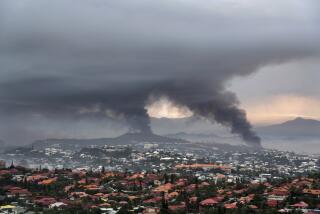200,000 Quebecers Rally to Turn Page in Their History : Canada: The occasion is a holiday. But the anticipation concerns a new status for the province.
MONTREAL — About 200,000 French-speaking Quebecers lined the streets of the East End of this city Monday, blowing horns, ringing bells and shouting such nationalistic slogans as “We want a country!”
In theory, the Quebecers turned out to watch the official parade for the Feast of St. John the Baptist, which this traditionally Roman Catholic province regards as its national holiday. But in fact they were marking the turning of a page in Canadian history and celebrating the prospect of some new, still-undefined relationship with Canada’s other nine provinces.
“I’m really hoping that we can negotiate a new approach with English Canada,” said Ernie Parent, a typographer who stood by the curbside waving a six-foot blue-and-white provincial flag, “because we can’t stand this any more. We’re drowning in a sea of Anglophones.”.
Quebecers feel poised for change now, thanks to the rejection last Friday of a package of constitutional amendments that would have given Quebec a special status within Canada. The amendments had taken on immense symbolic value here, and minutes after their defeat was acknowledged in the nation’s capital, the province’s premier, Robert Bourassa, went on television to announce that Quebec would always be a “distinct society,” able to pursue its own destiny. The next day he promised to step up the formulation of a new political approach for the province.
Monday’s religious parade gave Quebecers a chance to respond to this vague promise, and they expressed confidence and joy that over time their province will move away from English Canada. They also spoke with an inextinguishable idealism about what an independent Quebec might be like.
“We want to build a new country, a model for the world,” said Philippe Giguere, a university student who like many at the parade was dressed from head to toe in blue and white. “My idea is a Quebec without an army.”
Typographer Parent, meanwhile, was dreaming of a Quebec in which French-speakers, English-speakers, Indians and Eskimos would all participate as equals, proving to the world that racial justice is possible.
Many celebrants were quick to admit that they don’t expect political change to come soon. For one thing, the holiday season has begun in Canada, and with politicians out of town, it is unlikely that Bourassa’s new formula will be put together soon. Bourassa himself, moreover, is a longstanding federalist who fought the Quebec independence movement in the late 1970s. Given his background, many Quebecers are doubtful that he will be the one to lead their province to independence.
“Independence can’t be made just like that,” said university student Christian Guyuy. “It may take 15 or 20 years.”
During Quebec’s last surge of separatist feelings, bombs went off in Montreal, two officials were kidnaped and one of them murdered and the St. John the Baptist Day parade itself had to be canceled due to rioting. Participants in Monday’s festivities who were old enough to remember those times remarked on the difference in mood now.
“People were afraid that there would be trouble,” said accountant Brenda Brulotte. “This (independence movement) was born in violence in the 1970s, with the kidnaping of diplomats and murder. But now we know we can do it without violence. We’re thrilled. (English Canadians) have given us the OK.”
It was a day of music, pageantry and symbolism, with marching bands and floats representing various aspects of the Quebec economy. Celebrants climbed trees and traffic lights for a better view, drank beer, danced and ate blue-and-white Popsicles.
Quebec’s leading provincial opposition party, the Parti Quebecois, which advocates all-out independence, handed out thousands of placards proclaiming “Our real country is Quebec,” and people waved them proudly. A light plane circled overhead, towing a banner with the same message. Every time it passed, the crowd cheered.
Perhaps the most controversial float in the parade was a huge, stylized model of a sheep. Years ago, organizers of the St. John the Baptist parades always included a curly-headed boy with a live sheep by his side to represent the shepherd-saint.
But as separatist feelings grew in the 1960s and 1970s, Quebecers began to object to the sheep, arguing that it represented submission and docility. By the late 1960s, the live sheep had been dropped.
This year’s sheep statue carried a sign explaining that it was a “Trojan sheep,” evidently a cousin of the Trojan horse and a symbol of subversion rather than submission. But the crowd didn’t take to the idea.
“We’re not sheep any more,” people in the crowd grumbled when the statue rolled by.
More to Read
Sign up for Essential California
The most important California stories and recommendations in your inbox every morning.
You may occasionally receive promotional content from the Los Angeles Times.










